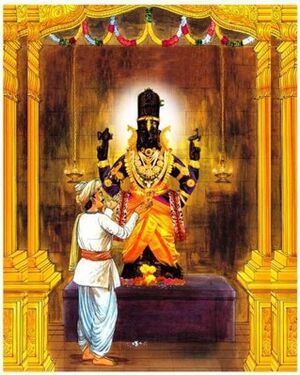Talk:Intolerance, Fanaticism
By Vishal Agarwal
Intense love towards the Bhagavān as one sees him can sometimes lead to an aversion or even hatred towards those who love the Bhagavān differently. Or it can lead to intolerance towards expressions of Bhakti that are different from one’s expression because the Bhakta believes that only his practice is perfect.: E.g. looking down upon Bhaktas who love chanting just because you prefer reading scriptures. Or fanaticism against people of other religions traditions. As Swami Vivekananda says:
“The one great advantage of Bhakti is that it is the easiest and the most natural way to reach the great divine end in view. Its great disadvantage is that in its lower forms, it oftentimes degenerates into hideous fanaticism. The reason for this is that to many an undeveloped mind, the singleness of attachment to one object or ideal (Nishtha) is possible only by hating the ideals and personalities adored by others. Their love is like the canine instinct of guarding the master’s property against all intrusion; but while the dog can recognize the master in any garb, the fanatic cannot! The best safeguard against this tendency is to develop a noble character in which knowledge, love, and Yog are harmoniously fused. For attaining the heights of spiritual consummation, the bird of the aspirant should be equipped for flight with the two wings of knowledge and love, and with the tail of Yog as a rudder for steering.[1]”
The Hindu tradition offers numerous approaches to the Divine, through multiple practices and allowing us to worship one or more of the infinite Divine manifestations. The structure of Abrahamic religions is different. Devotion towards the Bhagavān in these religions naturally leads to fanaticism, as witnessed frequently in their historical records, because of their structure which disallows diversity of belief, and practice and also actively rejects ‘heterodox’ approaches as a ‘sin’ against the Bhagavān. This has been discussed in somewhat detail in Section 14.14 above. Nevertheless, a few exceptional cases of religious conflict have been noticed in the Hindu tradition. Overall, however, Hindu Dharm is well-known for its tolerance towards other faiths, and also for harmony between different Hindu traditions. Stories like the one below emphasize how respecting diverse traditions makes one a better devotee of one’s tradition.
Bhakta Narahari Sonār who Saw Vishnu but touched Shiva
We should respect all Forms of Bhagavān. We should not make fun of someone else’s Ishta Devata. Hindus who make fun of other people’s Ishta Devata or their religion cannot be good Hindus. Let us now read the story of a man who loved Shiva but hated Vishnu. Let us see how Bhagavān Shiva taught him a very useful lesson about loving both Shiva and Vishnu.
The town of Pandharpur was famous for its temple of Vithoba, a form of Bhagavān Vishnu. In that town also lived a famous goldsmith named Narahari. He was a great bhakta of Shiva but he decided that he would not worship any form of Bhagavān but Shiva.
Once, a rich merchant who had no son made a promise to Vishnu that if he became a father, he would give a gold waistband to Vithoba’s Murti to thank Bhagavān. His prayers were answered. Soon, a boy was born to him and his wife. The merchant approached Narahari and requested him to take the waist measurement of the mūrti of Vithoba for making the gold waistband. But Narahari refused flatly even if that meant losing the business. So the merchant offered to measure it himself and bring the measurement to Narhari. He went to the temple, took the measurement, and then gave it to Narahari. Unfortunately, when the gold waistband was put around the murti, it was found to be somewhat shorter than needed. The merchant took it back to Narahari and requested him to add one more section to make it a bit longer. But, this time the merchant discovered that the waistband was a little too long.
Annoyed, the merchant requested Narahari to go himself to the temple to measure the murti’s waist. Narahari did not even want to see the murti of Vishnu Vithoba, but he agreed on the condition that he would be taken blindfolded to the temple. The merchant agreed to this condition. While Narahari was being taken to the Mandir with the blindfold, the pilgrims took pity on him for his foolishness for not seeing the beautiful murti. But Narahari would not change his mind.
There inside the temple, the blindfolded Narahari placed his tape measure around the Mūrti of Vithoba. But instead of feeling the stone murti, he felt elephant skin, just like the skin that Shiva wears on His waist. Narahari was a little shocked. He put the tape measure around the waist again. But once again, he felt a murti of Shiva with an elephant skin around it. Narahari was convinced that the foolish worshippers of Vithoba were worshipping a murti of Shiva.
So he took off his blindfold. But now he got a bigger surprise. He saw that he was indeed looking at the murti of Vishnu Vithoba and there was no elephant skin around its waist. He tied the blindfold again around his head and started measuring the waist. But once again, he felt that he was touching the Mūrti of Shiva. Upon taking off the blindfold, Narahari now saw again that it was Vithoba and not Shiva.
Narahari understood what Shiva was trying to teach to him – that Shiva and Vishnu are one and it was foolish on the part of Narahari to assume that he could worship Shiva but ignore Vishnu because They are one half of each other.
References[edit]
- ↑ Tapasyananda, Swami. The Four Yogas of Swami Vivekananda. Advaita Ashram, 2010, pp. 98–99.

